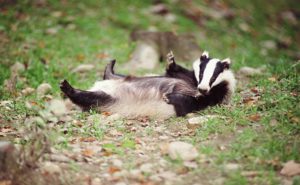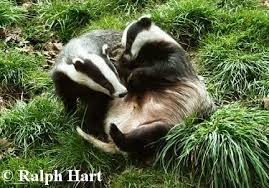A guest blog from PTES intern Alice Kent on her project with WildCRU, University of Oxford.
During my internship under supervision of Dr. Christina Buesching at the Wildlife Conservation Research Unit, University of Oxford, I investigated if European badgers (Meles meles) suffer from sexually transmitted diseases (STDs). For this research, I focused on two potential candidates: Chlamydia and herpesviruses, which are both well known to cause sexually transmitted infections in people. In other mammals, Chlamydia can have devastating effects on reproduction, causing abortion and diseases of the reproductive tract. These reports are particularly well documented in livestock due to the resultant economic losses for farmers. In addition, Chlamydia is also prevalent among Koalas and is believed to be responsible for the 51% decline of a population in south-east Queensland in recent years. Herpesviruses are also implicated in reproductive diseases, abortions and stillbirths; symptoms frequently caused by equid herpesviruses in horses.  Despite the adverse effects that Chlamydia and herpesviruses can have on the breeding success of mammals, these STDs are considerably under-researched in wildlife populations. Due to the highly promiscuous nature of the European badger, where both males and females will mate with multiple partners, this species represents a good model to investigate STDs. Moreover, reproductive failures, including abortion, infertility and loss of embryos are common in badgers and litters are small, in my study population on average about 1.4 cubs per year. Explanations for this low fertility rate are usually related to the environment, the badger’s behaviour or genetics, when STDs could be playing a part.
Despite the adverse effects that Chlamydia and herpesviruses can have on the breeding success of mammals, these STDs are considerably under-researched in wildlife populations. Due to the highly promiscuous nature of the European badger, where both males and females will mate with multiple partners, this species represents a good model to investigate STDs. Moreover, reproductive failures, including abortion, infertility and loss of embryos are common in badgers and litters are small, in my study population on average about 1.4 cubs per year. Explanations for this low fertility rate are usually related to the environment, the badger’s behaviour or genetics, when STDs could be playing a part.
For this research, I tested samples collected by WildCRU’s Dr. Christina Buesching and Dr. Chris Newman from the well-known badger population in Wytham Woods, Oxfordshire, for Chlamydia at the University of Surrey under Prof. Mark Chambers from the School of Veterinary Medicine, while the presence of herpesviruses was investigated by Dr. Bernhard Ehlers at the Robert-Koch Intitut in Berlin, Germany.
 All samples were negative for Chlamydia, although a specific herpesvirus called Mustelid herpesvirus-1 (MusHV-1) was found in 15 out of the 38 screened badgers. Interestingly, this is a much lower prevalence of herpes in genital swab samples, than a previous study found in Wytham’s badgers, where 98.1% tested positive for MusHV-1 from blood samples. Looking at life-history traits of individual badges, there was no difference in body condition between infected badgers and uninfected badgers, nor was there a difference in mean teat size (a good indicator for recent lactation) of infected badgers compared to uninfected badgers. In fact the majority of infected (62%) and uninfected badgers (57%) had not lactated, and similar numbers of infected (38%) and uninfected badgers (43%) had lactated. This indicates that, in badgers, infection from MusHV-1 does not negatively affect female reproduction. Nevertheless, the screening of more badgers is required to support this conclusion. Infected and uninfected badgers were associated with the same setts and social groups, providing implications that specific individual characteristics of badgers, such as immunity or promiscuity, are predisposing some female badgers to infection more than others.
All samples were negative for Chlamydia, although a specific herpesvirus called Mustelid herpesvirus-1 (MusHV-1) was found in 15 out of the 38 screened badgers. Interestingly, this is a much lower prevalence of herpes in genital swab samples, than a previous study found in Wytham’s badgers, where 98.1% tested positive for MusHV-1 from blood samples. Looking at life-history traits of individual badges, there was no difference in body condition between infected badgers and uninfected badgers, nor was there a difference in mean teat size (a good indicator for recent lactation) of infected badgers compared to uninfected badgers. In fact the majority of infected (62%) and uninfected badgers (57%) had not lactated, and similar numbers of infected (38%) and uninfected badgers (43%) had lactated. This indicates that, in badgers, infection from MusHV-1 does not negatively affect female reproduction. Nevertheless, the screening of more badgers is required to support this conclusion. Infected and uninfected badgers were associated with the same setts and social groups, providing implications that specific individual characteristics of badgers, such as immunity or promiscuity, are predisposing some female badgers to infection more than others.
I am very grateful to the People’s Trust for Endangered Species (PTES) for providing me with this internship funding and enabling me to carry out this project and to Nida Al Fulaij from PTES for all her patience and support. An especially big thank you goes to Prof. Macdonald and the Wildlife Conservation Research Unit for hosting me during this time. I would also like to express my huge gratitude to my supervisor Dr Christina Buesching from WildCRU, Oxford University and our collaborator Prof. Mark Chambers, University of Surrey, for their great guidance, support and input. A great thank you is owed to Dr Tom Mendum for all his hard work conducting the DNA extractions and Dr Bernhard Ehlers and his team from the Robert Koch-Institut in Berlin for dedicating considerable time and effort to screening my samples for herpesviruses. Thank you very much to Dr Giselda Bucca for all her amazing help and training me on the Quant 7 Studio and to Miss Debra Hau for her continued support in the lab. Finally, I want to emphasize my huge appreciation for the fantastic advice and support provided by Thermofisher’s Technical Application Scientists, especially Dr Snigdha Sharma and Jay Foxall from StarLab, for my laboratory work, and to Prof. David Macdonald for his generous offer of free accommodation in Tubney during my time in Oxford. An especially big thank you is owed to Lynne Larkman for her continuous and enormous help with my project that went far beyond her call of duty. The support of the other members of WildCRU’s badger team, Dr. Chris Newman, Mike Noonan and Nadine Sugianto, during field work and sample collection was hugely appreciated.
